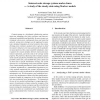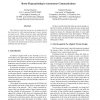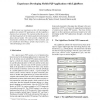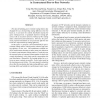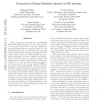P2P
2006
IEEE
14 years 11 months ago
2006
IEEE
P2P systems that rely on the voluntary contribution of bandwidth by the individual peers may suffer from freeriding. To address this problem, mechanisms enforcing fairness in band...
P2P
2006
IEEE
14 years 11 months ago
2006
IEEE
The advent and popularity of the World Wide Web (WWW) has enabled access to a variety of semi-structured data and, when available, this data follows some common XML schema. On the...
P2P
2006
IEEE
14 years 11 months ago
2006
IEEE
Content storage in a distributed collaborative environment uses redundancy for better resilience and thus provides good availability and durability. In a peer-to-peer environment,...
P2P
2006
IEEE
14 years 11 months ago
2006
IEEE
Peer discovery and route set-up are an integral part of the processes by which anonymizing peer-to-peer systems are made secure. When systems are large, and individual nodes only ...
P2P
2006
IEEE
14 years 11 months ago
2006
IEEE
In this paper, our experiences so far with developing a platform for mobile P2P applications with the LightPeers framework are presented. We experienced that the use of a role-bas...
P2P
2006
IEEE
14 years 11 months ago
2006
IEEE
We describe the problem of data dissemination in stream-oriented applications where the required filter is a function of the current state. We call such functions dynamic filter...
P2P
2006
IEEE
14 years 11 months ago
2006
IEEE
The idea of building query-oriented routing indices has changed the way of improving routing efficiency from the basis as it can learn the content distribution during the query r...
P2P
2006
IEEE
14 years 11 months ago
2006
IEEE
Peer-to-peer grids aim to build computational grids encompassing thousands of sites. To achieve this scale, such systems cannot rely on trust or off-line negotiations among partic...
P2P
2006
IEEE
14 years 11 months ago
2006
IEEE
Peer-to-peer systems (p2p) are highly dynamic in nature. They may consist of millions of peers joining only for a limited period of time, resulting in hundreds of join and leave e...
P2P
2006
IEEE
14 years 11 months ago
2006
IEEE
Given some of the recent advances in Distributed Hash Table (DHT) based Peer-To-Peer (P2P) systems we ask the following questions: Are there applications where unstructured querie...

